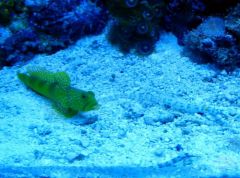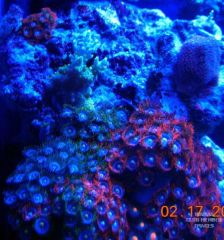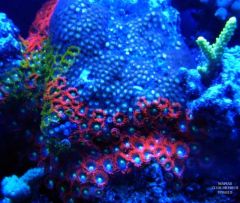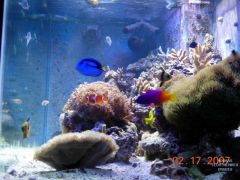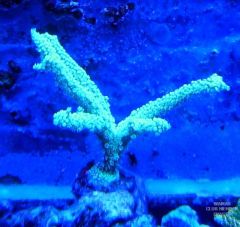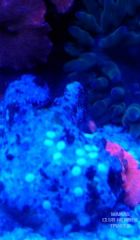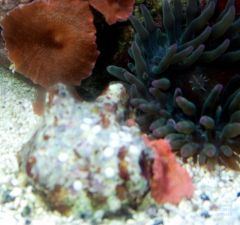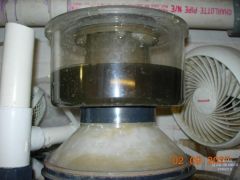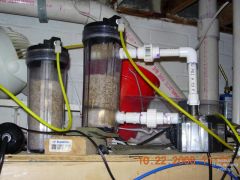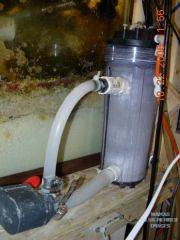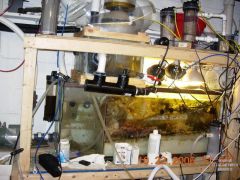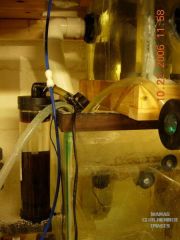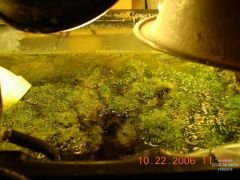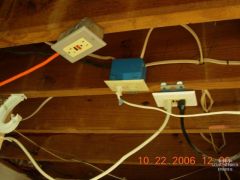
Rascal
BB Participant-
Posts
1,355 -
Joined
-
Last visited
Content Type
Profiles
Forums
Gallery
Events
Store
Everything posted by Rascal
-
From the album: 150 Reef (2/07 - 8/07)
pic -
From the album: 150 Reef (2/07 - 8/07)
pic -
From the album: 150 Reef (2/07 - 8/07)
pic -
From the album: 150 Reef (2/07 - 8/07)
pic -
From the album: 150 Reef (2/07 - 8/07)
pic -
From the album: 150 Reef (2/07 - 8/07)
pic -
From the album: 150 Reef (2/07 - 8/07)
pic -
From the album: 150 Reef (2/07 - 8/07)
pic -
-
From the album: Sumps & DIY stuff
pic -
I don't agree that setting up a tank this way is the same as completely starting over from scratch. Not when the tank is filled with pods, worms, sponges, coraline, and bacteria right from the start. When I did this I never saw even a hint of ammonia, nitrite or nitrate -- and I transferred all of my livestock at the same time. I would imagine you experienced something similar. You already have a working population of bacteria on the rocks that you transferred from the old set up. On the other hand, the disruption of the move definately has its effects, and it takes a while to get back the same level of stability as you had in the old tank. At least for me it did. Lots of kinks to be worked out. As far as maturity, IME the sand bed takes more than a few months to really start doing its job. I am not sure how long, but I know I can see a huge difference in mine now (7 months) compared to 3-4 months ago. Huge difference in my tank, too. I did not go through the same initial cycle as you would get when starting from scratch, but I did have some red cyano early on and a hair algae bloom that peaked around 3 months. At this point all but a few traces of the algae are gone I am seeing good growth and PE on just about all of my frags. Not sure if I would call my tank "mature" yet or not, but it's getting there. The bottom line is that everyone's tank and situation is different. Look at Dandy's tank for example. I had the pleasure of seeing it at about 6 months and couldn't believe the health and growth of all the SPS he had in there. I think he recently posted after adding his 50th coral. Most reefers would struggle to keep 1/10th of that in a tank so young, but his tank looks amazing. "Mature reef" probably means different things to different people. It makes more sense to me just focus on the health of the animals and quality of care you can provide and stay away from labels. If you add something and it doesn't do well, try to figure out why and fix it before you add another. If everything does great right from the start, get to work on setting up that frag tank so you can share your success with the rest of us!. Just my $.02 as always.
-
I don't think you need to spend $600. Consider a DIY. You don't have necessarily need a lot of tools or skill with acryllic to put together a workable reactor. For about a year, I have been using one made from a couple of RO canisters and a Mag3. . It's not pretty, but it works. I just got the parts today for a slightly bigger version -- generally based on this: http://reefcentral.com/forums/showthread.p...mp;pagenumber=1 Should be even easier to construct than what I've got now -- no drilling acrylic. I am going to put a dispersion plate near the bottom and have all of the output of the recirc pump come out underneath that, so mine will hold a little bit less media than the one in the thread -- but as long as I can get over 4 lbs in there, that should be enough. Cost: $74 from Lowes $85 Milwaukee Regulator/solenoid/bubble counter/ $100 (?) 20 lb CO2 tank (I can't remember how much this cost) $20 media $60 pumps (I use a spare MJ as a feed pump, plus the Mag3 for recirc). The reactor itself can be built for not much more than $100 (less if you have extra pumps and plumbing fittings lying around). The biggest cost is the CO2 equipment. Someday I'll probably add a PH monitor but I too don't consider them necessary. If you use a media like A.R.M., you don't need to drop the reactor PH all that low anyway. I also run mine through a second chamber and I have the output so that it mixes with the output of my skimmer so any CO2 that remains is effectively off-gassed. The overall effect on my tank's PH is minimal. I do think that the solenoid is important, however. The reason is that if you don't have it and power goes out, the CO2 will keep going, building up in your sump. When power comes back on, all of that can hit your tank at once, causing a rapid drop in PH. I believe that's how I lost 3 fish after a 7 hr power outage last summer. All fish were fine when the power came back on at 0300. When I next checked at 0800 three were belly up and 2 sps had bleached. Painful lesson learned. Sorry for the long post. I just read your title again and realized you were looking for advice from the Experts. That's not me by a long shot, but I thought I'd share my experience anyway.
-
Wally's, Centerville Aquarium, and Marine Scene all carry it. I don't think superpetz does.
-
Jake, with the amount of healthy sps in your tank, I would think that your Alk would drop in no time if you just stop supplementing. I wouldn't be suprised if you dropped a full point of dKh per day, or more. I had Alk off the charts not too long ago (my piece of junk test kit said 11 dKh, then I switched to Salifert and realized I was over 17!!!). I just shut off my Ca reactor and bypassed my Kalk reactor, and then tested every day. I added just the Calcium part of B-Ionic 2-part solution to maintain calcium until the Alk came down.
-
I used to use the DIY bottle drip method and it worked fine. The only real difference is that you have to do that everyday vs a Kalk reactor where you are just changing out Kalk every so often. For me, that made a big difference. Running tubing to your tank is really the same sort of problem as running wire. You can either go through the ceiling, the walls, under the floor (not an option for you), or try to hide it under the carpet. The first two involve a lot of drywalling. One option might be to use some kind of a cable or conduit raceway, but I don't know how well that would work/look. A compromise would be to put a smaller resevoir under the the tank that you could manually refil with RO/DI water however often you needed to and then use that to feed the kalk reactor. Even a simple 5G bucket might work well for this purpose if had room for it.
-
FW dips are supposed to work very well with these worms. I bought a Yellow Tang once that was practically covered in black spots. It was well fleshed and eating like crazy so I decided to take a chance. I put it in a tank with 3 skunk cleaner shrimp. He spent a lot of time at their little "stations" and within 2 days all spots were gone. I had the fish for over 7 months and never saw another spot on it. Sad end to the story: it died in a power outage while out was out of town last July. :( Give the shrimps a chance.
-
I think GE Silicone II is the stuff that does contain mildewcide. Silicone I doesn't -- it still says it is mold/mildew resistant after it cures, but that is just a property of silicone. Interestingly enough, both of them say they are 100% silicone. It also comes in various colors, and still says it is 100% silicone. Guess I just wasn't that good in math. Some LFS also sell "Aquarium Sealant" in kaulk-gun size tubes. IMO you would be fine w/ Silicone I. I also think you would be better off just getting a new/used tank, though. Have you figured out what caused it? Was the stand perfectly planar and level?
-
Another thing to consider is the possibility that your sand bed isn't really working up to its full potential yet. Same with the low oxygen sections inside your live rock (the other place where denitrification takes place). I may be mistaken, but I think I remember reading somewhere that a DSB takes at least 6 months to really start doing its job. I know that has been my experience anyway. That's not to say that more flow and being careful with overfeeding aren't good ideas, I'm just giving you something else to think about.
-
I have this whole series on DVD -- 4 discs with 8 programs. Amazon is selling it now for $39. Each one is simply breathtaking. The photography blows me away every time I see it. I have lost count how many times we have watched them. One of the best parts (for me) about it is that young kids love them too. Sure beats the h**l out of watching some stupid singing mind-numbing purple dinosaur or stuffed dragon or whatever.
-
Possibly not, because in all likelihood that foam filter is crawling with pods. I float a polyfilter pad in the return section of my sump, and I know they love that. If the pods are in the filter, some of them will most likely be falling off and making their way to your display. You may want to reconsider the use and/or placement of the foam filter for other reasons, though. Seems like it could end up a nitrate factory if not rinsed quite often. IMO mechanical filtration is best employed before the skimmer, if at all. Just my $.02 though.
-
Try checking the wire connections in the endcaps. You may have to take the endcaps apart to remove the wires, then put the endcaps back together again before reinserting the wires.
-
Nevertheless, many will end up making it into your display, even surviving the impeller on your return pump. That's all part of the benefit. The pods help feed your fish, and their eggs and larva are food for corals.
-
I just had a very interesting thought....
Rascal replied to madmax7774's topic in Conservation & Sustainability
I can't figure out how to copy images from another web site, but if you follow these links you can read some good info on the biorock projects. Second link has photos. http://www.globalcoral.org/Report%20of%20t...%20Workshop.htm http://www.globalcoral.org/Third%20Pemuter...%20Workshop.htm Personally, I find NOAA's current policy/stance unfortunate. It seems that given the current state of knowledge in hobby, introduction of parasites and disease could be easily controlled. Then again, what do I know? -
I have a 400W (800W peak) inverter that I can lend you (free) or sell you ($25 - I paid $40 last year and have used it once). I just upgraded to a 750W to use on one of those DIY battery back-ups. Been meaning to put this one up for sale just haven't gotten around to it yet. Anyway -- it is at my house in Annandale. Very easy to use. Just hook it up to your car battery and plug in an extension cord. 400 watts should be enough to power most return pumps. It will run for as long as you have gas in your car. Give me a call (703 402 5276) if you need it.
-
I see now why you want to use a 2nd pump. Yes, you can drill acrylic with a regular hole saw, but it can be difficult. You have to control the speed just right or it will melt too much. Every time I have done it I have ended up needing to use a dremel to smooth things out a bit. The only acrylic work I have done has involved using Weldon to attach and seal PVC fittings in the holes. I have no idea how you go about installing a bulkhead in an acrylic tank. Maybe it's the same as with glass tanks? Hopefully one of the more experienced members will post here to help you out.



